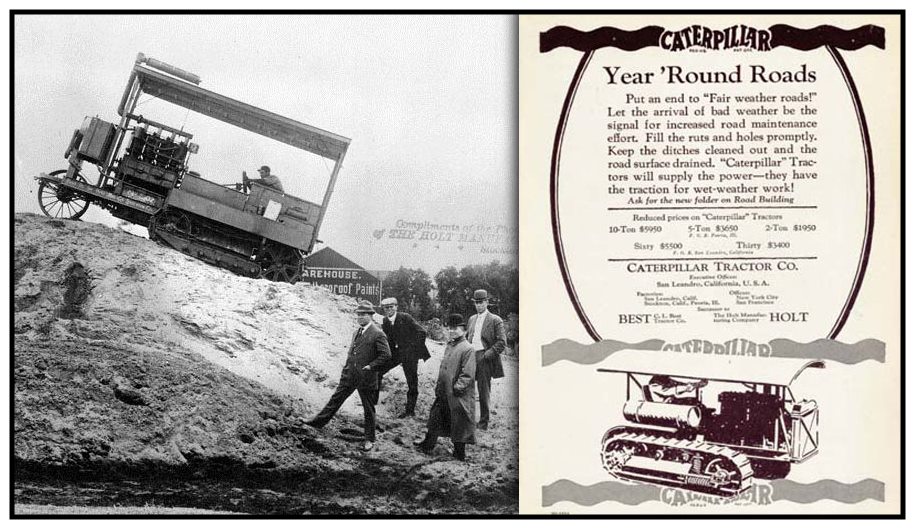
(Click to enlarge)
Caterpillar History
The story of Caterpillar Inc. originates in the late 19th century, when Daniel Best and Benjamin Holt experimented with ways to fulfill the promise that steam tractors held for farming. By 1904, these large steam-powered tractors had been plowing California fields for 14 years, and occasionally got bogged down in the soft soil, especially after heavy rains. Once stuck in the mire, they were difficult to pull free, even with teams of horses. Their great weight typically rested on four metal wheels.
One solution employed to alleviate this problem was to lay a temporary plank road ahead of the steam tractor, but this was time-consuming, expensive, and interfered with earthmoving. Holt came up with the idea to carry the road with the vehicle. On November 24, 1904 he added wooden block-linked treads around the idlers on Holt No.77, his test tractor. The results were impressive, and the modern tractor was born. Caterpillar became famous for its Caterpillar 30 and its Caterpillar 60 tractors.
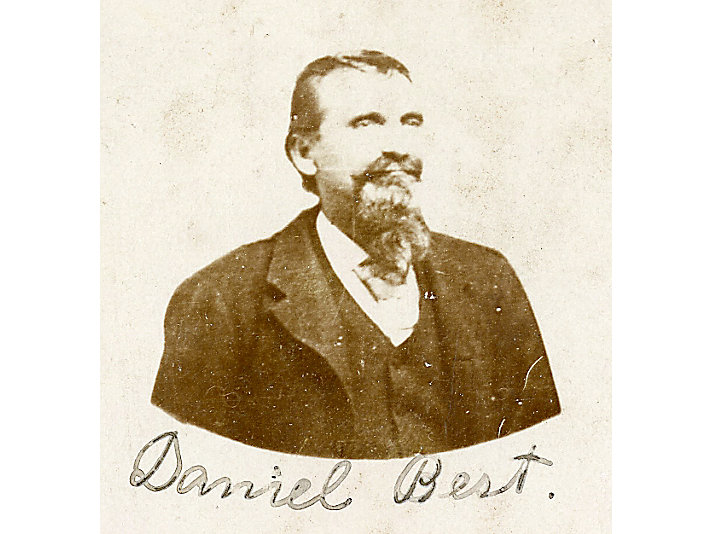
Daniel Best
(Click to enlarge)
In 1909, Benjamin Holt bought the abandoned but relatively new manufacturing plant of a tractor company that had failed in East Peoria, Illinois. The location offered Holt everything he needed in a manufacturing center, and despite the hefty amount of capital needed for retooling the plant, the venture proved so profitable that by 1911 the factory employed 625 people. Around that time, Holt Manufacturing began exporting its tractors to Argentina, Mexico, and Canada, in addition to their domestic sales. The Holt Manufacturing Company later pioneered the use of the continuous track during World War I. Their crawler tractors inspired the first military tanks, which helped end World War I.
Caterpillar formed on April 15, 1925 with the merger of Holt Manufacturing Company of Stockton, California and the C. L. Best Gas Traction Company of San Leandro, California, forming the Caterpillar Tractor Co. Sales the first year were US$13 million. By 1929, sales climbed to $52.8 million, and CAT continued to grow throughout the Great Depression of the 1930s.
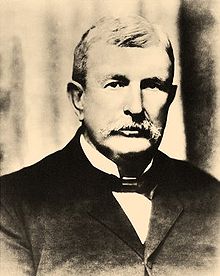
B Holt
(Click to enlarge)
After the companies merged, Caterpillar went through many changes, including the adoption of the diesel engine. During World War II, Caterpillar products found fame with the Seabees, Construction Battalions of the United States Navy, who built airfields and other facilities in the Pacific Theater of Operations. During the post-war construction boom, the company grew at a rapid pace and launched its first venture outside the U.S. in 1950, marking the beginning of Caterpillar's development into a multinational corporation.
Business Lines
As of the first quarter of 2006, 44% of Caterpillar's sales are to overseas customers. Caterpillar products are sold in nearly 200 countries. The company has a worldwide network of 220 dealers: 63 dealers in the United States and 157 in other countries. Caterpillar products and components are manufactured in 51 plants in the United States and 59 plants in Australia, Belgium, Brazil, Canada, England, France, Germany, Hungary, India, Indonesia, Italy, Japan, Mexico, the Netherlands, Northern Ireland, the People's Republic of China, Poland, Russia, Singapore, South Africa and Sweden. Caterpillar also licenses the manufacturing of Caterpillar-branded clothing, hats, footwear, and other consumer products.
Caterpillar's historical manufacturing home is in Peoria, Illinois, where its world headquarters and core research and development activities are located. Although Caterpillar has "farmed out" much of its local parts production and warehousing to outside firms, it still has four major plants in the Peoria area: the Mapleton Foundry, where diesel engine blocks and other large parts are cast; the East Peoria factory, which has assembled Caterpillar tractors for over 70 years; the Mossville engine plant, built after World War II; and the Morton parts facility.
Vehicles
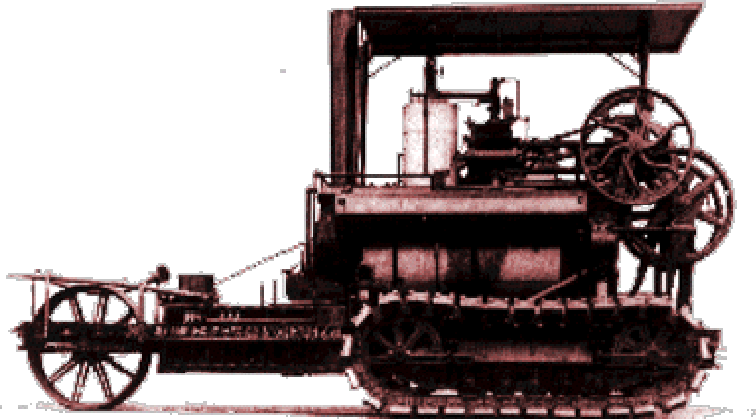
First Cat
(Click to enlarge)
Caterpillar Tractor - 1904; first successful crawler tractor, equipped with a pair of tracks rather than wheels.
Caterpillar has a list of some 400 products for purchase through its dealer network. Caterpillar's line of vehicles range from tracked tractors to hydraulic excavators, backhoe loaders, motor graders, off-highway trucks, wheel loaders, and agricultural tractors. They are used in construction, road-building, mining, forestry, energy, transportation and material-handling industries.
Caterpillar is the world's largest manufacturer of wheel loaders. The medium size (MWL) and large size (LWL) are designed at their Aurora, Illinois facility. Medium wheel loaders are manufactured at: Aurora, Illinois; Sagamihara, Kanagawa, Japan; Gosselies, Charleroi, Belgium; Piracicaba, S„o Paulo, Brazil; India and the People's Republic of China. Large wheel loaders are manufactured exclusively in the United States on three separate assembly lines at Aurora, Illinois.
Engines
A portion of CAT's business is in the manufacturing of diesel and natural gas engines and gas turbines, which, in addition to their use in the company's own vehicles, are used as the prime movers in locomotives, semi trucks, and ships, as well as providing the power source for peak-load power plants and emergency generators.
Caterpillar Defense Products
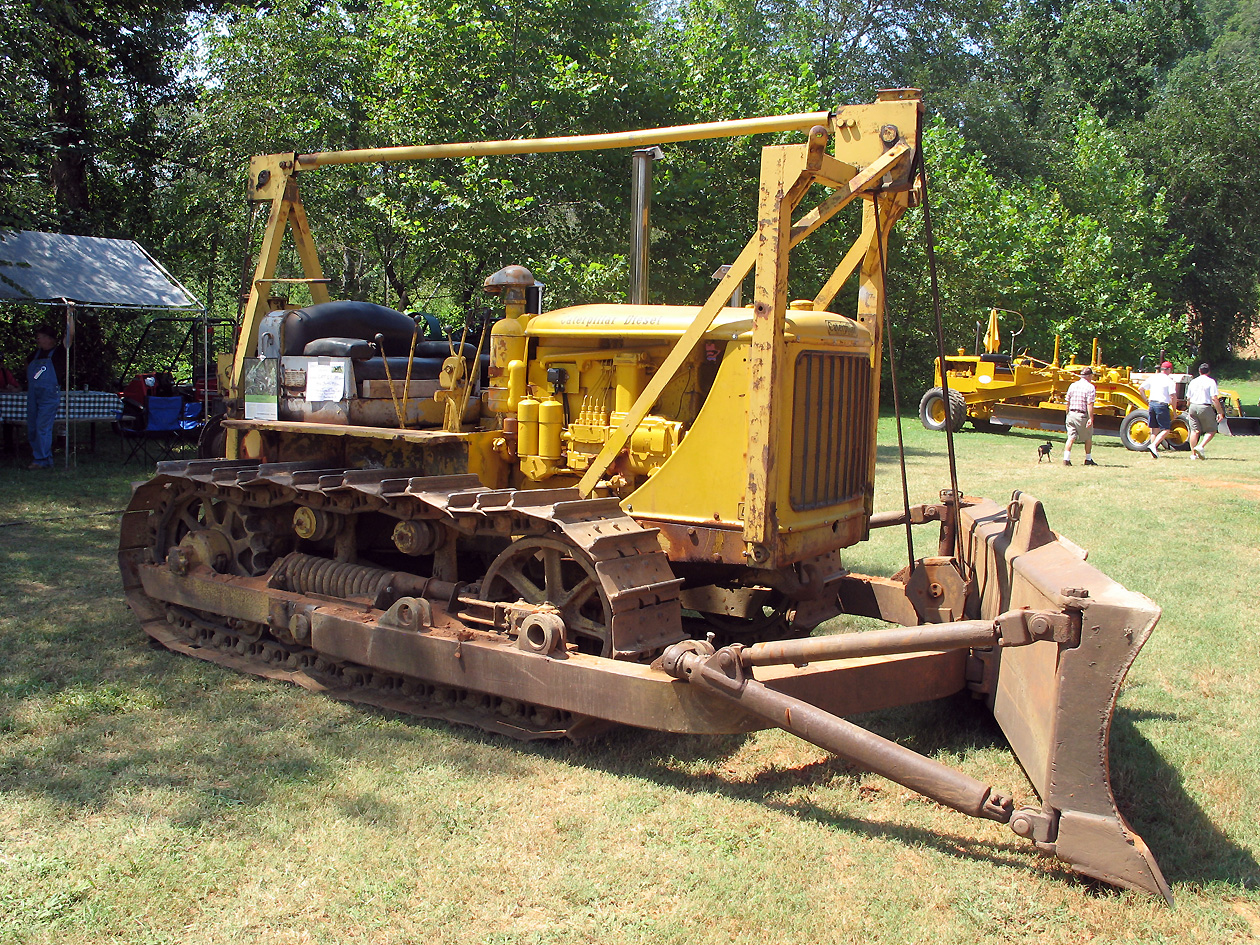
Caterpillar D7 7M
(Click to enlarge)
Caterpillar D7 7M series tractor, operated by MSGT Knowles Freeman from Pensacola, FL, 829th Engineer Construction Company, while building an airport near Eye, England, 2 March 1943. Although not on this unit, the D7 7M tractors were typically fitted with a LeTourneau WCK-7 angledozer blade operated by the rear mounted power control unit.
The Caterpillar Defence Products subsidiary, headquartered in Shrewsbury, Shropshire, provides diesel engines, automatic transmissions and other parts for the UK's Titan armored bridge layer, Trojan combat engineering tank, Terrier combat engineering vehicles, and tank transporters; the Romanian MLI-84 armored personnel carrier and the Swiss Piranha III light armored vehicle, which is currently being developed for use by American light armored formations; large fleets of military trucks in both the U.S. and UK; and the CV90 family of infantry fighting vehicles used by the armies of Sweden, Norway, Finland, Switzerland, the Netherlands and Denmark.
This division also provides both propulsion engines and power generation systems to the naval shipbuilding industry, such as the Series 3512B turbocharged V-12 diesel engine for American Virginia class nuclear submarines. Caterpillar diesel engines are also used in San Antonio class amphibious transport docks, Spanish Alvaro de BazŠn class frigates, British River class patrol vessels, Mexican Sierra class patrol boats, and Malaysian Kedah class MEKO A-100 offshore patrol vessels.
Caterpillar Electronics
The Caterpillar Electronics business unit has formed Caterpillar Trimble Control Technologies LLC.,(CTCT), a 50:50 joint venture with Trimble Navigation to develop the next generation of advanced electronic guidance and control products for earthmoving machines in the construction, mining and waste industries. Caterpillar Trimble Control Technologies LLC is based in Dayton, Ohio and started its operations on April 1, 2002
Product Distribution
Caterpillar branded products are distributed to end-users through Caterpillar's worldwide dealer network. Caterpillar's dealers are independently owned and operated businesses with exclusive geographical territories. Dealers provide sales, maintenance and repair services, rental equipment, and parts distribution. Finning is Caterpillar's largest global distributor. Most dealers use the Dealer Management System called DBS(Dealer Business System) for their day to day operations
Notable Achievements and Controversies
Caterpillar has been involved in a number of "firsts". The crawler tractor that inspired the first military tanks were based in part on patents for a track design that the Holt Manufacturing Company bought from Richard Hornsby & Sons of England. The predecessor Holt tractor became one of the most important military vehicles of all time when it was used as an artillery tractor during World War I. Admiral William F. ?Bull? Halsey commented at the end of World War II, that ?The four machines that won the war in the Pacific were the submarine, radar, the airplane and the tractor-bulldozer." They have contributed to construction projects helped build the Hoover Dam, the U.S. Interstate highway system, the Channel Tunnel under the English Channel, and construct cities and neighborhoods across the United States. Caterpillar equipment helped to tumble the Berlin Wall but also to build the United States?Mexico border and Israeli West Bank border barriers.
Caterpillar built its first Russian facility in the town of Tosno, located near St. Petersburg, Russia. It was completed in 16 months and occupied in November 1999. It had the first electrical substation built in the Leningrad Oblast since the Communist government was dissolved on December 26, 1991. The facility was built under harsh winter conditions, where the temperature was below -25įC. The facility construction was managed Lemminkšinen Group located in Helsinki, Finland.
Currently under construction is the $125M Caterpillar Suzhou, PRC facility, which will manufacture World Class Medium Wheel Loaders and Motorgraders, primarily for the Asian market. The first machine is scheduled for production in March 2009. The facility construction is managed by URS Ausino, located in San Francisco, California.
"Excellent Company" Designation
Caterpillar was one of the "excellent" companies featured in the 1982 best-selling management book In Search of Excellence by Tom Peters. The company's written principles are the Code of Worldwide Business Conduct document that stresses integrity in every action.
In the 1990s, Caterpillar management adopted the Six Sigma quality management program in an effort to reduce costs and inventory, and identify and correct defects in the company's processes and products.





